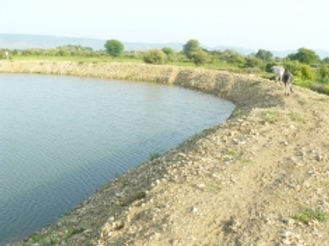Indigenous Methods
Indigenous methods play a key role in water conservation and protection. Traditional, indigenous practices have sustained populations while respecting the natural environment. They are a source of inspiration when looking to protect our water sources. Below are some successful examples of indigenous methods from varying geographical locations in India.
Bamboo Drip Irrigation in Meghalaya
In Meghalaya, India, bamboo drip irrigation is a system that has been successful for 200 years. It involves using pipes made of bamboo to irrigate plantations and works well for the rocky terrain and steep slopes. This system utilizes 20-80 liters of water which travels down the bamboo pipes into the fields. The water is outputted at 20-80 drops per minute which is very beneficial for crops such as betel leaf and black pepper. This practice, invented by tribal farmers in northeast India, continues to be extremely successful in the state and has inspired similar systems throughout the globe.

Credit: @DialogueSamvaad on Twitter
Zabo Water Conservation
in Kikruma
This indigenous practice dates back centuries and is practiced in Kikruma, a village in the Phek district of Nagaland. "Zabo" means impounding water and it involves using rainwater that runs off from mountains. It combines rainwater harvesting, forestry, and animal care. Forests are preserved on top of the hills to catch the rainwater, which then is brought through channels to small ponds. The water then passes through cattle yards and carries the urine and manure of the cattle, then goes into the paddy fields. The urine and manure are nutritionally beneficial for the soil. Fish also grow in these paddy fields, allowing for an additional benefit. The pond bunds grow various medicinal plants and herbs.
Watch a Kirkuma resident explain the system!

Credit: The Third Pole
Eri (Tanks) of Tamil Nadu
This system is one of the oldest water conservation practices in India, dating back centuries prior to British intervention. Over a third of irrigation in the state of Tamil Nadu is made possible by the use of eris, which are tanks. Some tanks are "system eris", meaning they are filled by using water that is diverted from river waters during monsoon season. Other eris are simply filled when it rains. Tanks are interconnected in order to ensure that neighboring villages further from the water source get access to water and to balance the water supply. Eris act as natural flood-control systems, prevent runoff and soil erosion during heavy rain, and recharge the groundwater.
%20of%20Tamil%20Nadu.jpeg)
Credit: India Water Portal
Johads of Rajasthan,
Haryana, Punjab, and
Western Uttar Pradesh
Prior to British intervention, johads were traditional structures for rejuvenating groundwater. In the 1980s, Rajendra Singth, also known as the "Water Man of Rajasthan" called to bring back these indigenous structures. The rebuilding of johads in Rajasthan allowed for the River Ruparel to come back to life after being dry for decades. Johads are small check dams built in areas with high elevation on three sides.

Credit: Shree Padre
This area is excavated, and the excavated material is used to build the fourth wall. Johads can be connected together as well to prevent structural damage. Today, there are over 4,500 johads in Alwar, Rajasthan alone. The emphasis on community support and indigenous wisdom is reviving johads throughout the states.
In 2019, the Haryana government released a plan to rejuvenate 16,400 johads in the state. They continue to be successful structures throughout various Indian states.
Ahar-Pynes of
South Bihar
Ahar-pynes are indigenous to South Bihar and are floodwater harvesting systems. Ahar-pynes date back to the Magadh dynasty about 5,000 years ago and are still practiced mainly in the Gaya district of South Bihar (as well in other districts). The system consists of "ahars" and "pynes", which work to support each other. An ahar is a catchment basin built to store harvested water with embankments on three sides. Pynes are diversion channels created to carry this rainwater from the river into the ahars. Ahar-pyne systems are what made caddy cultivation possible in Bihar.

Credit: Hindi Water Portal
Sources
-
Bpscnotes. “Ahar Pyne – Traditional Water Harvesting System of Bihar.” BPSC Notes, 16 May 2019, https://bpscnotes.com/2019/05/16/ahar-pyne-traditional-water-harvesting-system-of-bihar/.
-
Dewani, Usha. “Zabo: The Art of Impounding Water.” India Water Portal, 6 Aug. 2014, https://www.indiawaterportal.org/articles/zabo-art-impounding-water.
-
Eastern Coastal Plains : Traditional Water Harvesting Systems, http://www.rainwaterharvesting.org/Rural/east_coastplains.htm.
-
Eswaran, Sindhu. “Traditional Water Systems of India.” Sahapedia, 13 July 2020, https://www.sahapedia.org/traditional-water-systems-of-india-0.
-
“Johads.” JournalsOfIndia, 8 Aug. 2020, https://journalsofindia.com/johads/.
-
“Northeastern Hills.” Bamboo Drip Irrigation of the Noartheastern Hills - Rainwaterharvesting.org, http://www.rainwaterharvesting.org/methods/traditional/bamboo.htm.
-
Pal, Sanchari. “Modern India Can Learn a Lot from These 20 Traditional Water Conservation Systems.” The Better India, 15 July 2016, https://www.thebetterindia.com/61757/traditional-water-conservation-systems-india/#:~:text=The%20Eri%20(tank)%20system%20of,and%20also%20recharge%20the%20groundwater.
-
Studio18. “Learnings from the Past: India's Indigenous Water Conservation Methods.” Firstpost, 24 Aug. 2021, https://www.firstpost.com/blogs/learnings-from-the-past-indias-indigenous-water-conservation-methods-9909851.html.
-
Vyas 18 Nov, K G. “Ahar Pynes: Traditional Flood Harvesting Systems of South Bihar.” India Water Portal, 18 Nov. 2020, https://www.indiawaterportal.org/articles/ahar-pynes-traditional-flood-harvesting-systems-south-bihar.
-
“The Waterman of Rajasthan - Rajendra Singh.” The Waterman of Rajasthan Rajendra Singh, Waterman Rajendra Singh (Jal Purush), Rajendra Singh and Tarun Bhagat Sangh : Eco India, http://www.ecoindia.com/education/water-man-of-rajasathan.html.
Written by: Tehreem Qureshi
